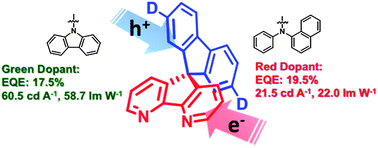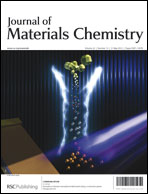We designed and synthesized a series of spiro-configured bipolar hosts (CSC, DSD, TST, and NSN) comprising electron-transporting 4,5-diazafluorene and hole-transporting carbazole or diarylamine with thorough characterizations of their thermal, photophysical, electrochemical properties, and carrier mobilities. Time-of-flight (TOF) measurements and single-carrier devices revealed these compounds had good hole and electron mobilities (10−5 − 10−7 cm2 V−1 s−1) together with promising physical properties, rendering them good host materials for efficient electrophosphorescence. The green PhOLED with (PPy)2Ir(acac) as the emitter incorporating CSC as the host exhibited a remarkable high brightness of 260 000 cd m−2 at 2400 mA cm−2 (11 V) with the maximum external quantum efficiency (ηext) of 17.1%, the ηext remained as high as 15.4% under a high brightness of 10 000 cd m−2 at a low operating voltage of 5.1 V even without p–i–n device configuration. The NSN-based PhOLED with the red dopant Os(bpftz)2(PPhMe2)2 has a maximum brightness of 77 900 cd m−2 at 1100 mA cm−2 (10 V) with the maximum ηext of 19.5%. The ηext remained as high as 19.1% under a practical brightness of 1000 cd m−2 (4.6 V). These results suggest that the spiro-configured D–A hosts are well-suited for achieving highly efficient PhOLED with limited efficiencies roll-off.

You have access to this article
 Please wait while we load your content...
Something went wrong. Try again?
Please wait while we load your content...
Something went wrong. Try again?


 Please wait while we load your content...
Please wait while we load your content...